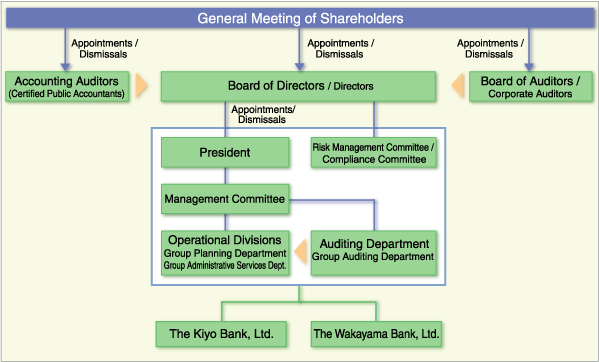|
Corporate Governance
1. Our Policy on Corporate Governance
Kiyo Holdings, Inc. (“the Company”) and every member of the Kiyo Financial Group views as a top priority the fostering of a corporate culture that emphasizes the importance of compliance by ensuring the transparency of management and the maintenance of high ethical standards, to enhance enterprise value through the strengthening of corporate governance.
2. Our Corporate Governance System

3. Corporate Governance Overview
(1) Expanding the Monitoring Function of the Board of Directors, and Accelerating the Decision-Making Process
At the Company, the Board of Directors is the highest decision-making body, and is responsible for supervising management. The Management Committee, headed by the president, is convened as required. This committee discusses the Group’s management strategy and management planning. We have endeavored to create a system that speeds up decision-making on actual policies that govern the execution of day-to-day operations.
To strengthen both the compliance system and the risk management system, which serve as the foundation for sound operations, we have set up a Compliance Committee and a Risk Management Committee, which report directly to the Board of Directors. The Compliance Committee discusses measures aimed at ensuring that management act in accordance with laws and regulations, and at raising awareness of compliance issues. The Risk Management Committee provides comprehensive Groupwide risk management, in accordance with a unified set of risk management regulations. The committee identifies all types of risk in a comprehensive manner, and discusses appropriate countermeasures. The contents of these discussions are summarized in a report that is submitted to the Board of Directors, enabling the Board to fulfill its own supervisory function.
(2) Audit Function
The primary role of corporate auditors is to supervise management. By working closely with accounting auditors (certified public accountants) and the Group Auditing Department, corporate auditors are able to obtain a clear overview of management. They also attend the Management Committee meetings and other committee meetings to carry out operational audits. In this way, they are able to ensure the functioning of an appropriate system of checks and balances.
The Board of Corporate Auditors comprises five statutory auditors, including three external auditors.
(3) Internal Auditing, Risk Management, and Compliance System
We have set up the Group Auditing Department as a unit to coordinate the activities of all the internal auditors at Group companies. In addition to conducting internal audits within the Company, this department also monitors the status of internal audits at Group member companies, verifying the appropriateness and effectiveness of internal audits.
In addition, we have established a Group Management Department to oversee groupwide risk management activities. This move seeks to ensure the autonomy of the risk management and compliance divisions, and, through the creation of centralized risk management system, aims to upgrade our risk management capabilities.
(4) Improving Disclosure
The Group is working to enhance the transparency of management through the timely release of important information. To diversify its methods of information disclosure, the Group is working to utilize of its website actively and expand the disclosure reports.
| Decision-making and consultative bodies |
| Decision-Making and Consultative Bodies |
Objectives, Checks & Balances, Reporting System |
| Board of Directors |
This highest decision-making body in the execution of business operations monitors the conduct of business operations by each director. |
| Compliance Committee
|
Makes sure that every Group company adheres closely to all laws and regulations and does not violate generally accepted ethical standards, and that business activities are conducted in a fair and ethical manner. The committee discusses important compliance-related matters, and submits reports and advisories to the Board of Directors. |
| Risk Management Committee |
The committee identifies all varieties of risk management systems from the overall perspective of risk management of the entire the Group. It then determines appropriate countermeasures, and makes reports and issues notifications to the Board of Directors.
From the viewpoint of managing earnings fluctuations, it then confirms that the risk management system provides an adequate response, ensuring that each response directly corresponds to the degree and type of risk. The Committee exerts checks and balances over the activities of the risk management divisions and the operational business divisions. |
| Management Committee |
This committee is the highest decision-making body at the operational level, and is presided over by the president. The committee considers important management issues in light of policies laid down by the Board of Directors. |
| ALM Strategy Committee |
The ALM Strategy Committee, a body that reports directly to the Management Committee, examines all types of portfolios under management and formulates the Group’s management strategies from the perspective of risk and return, with the aim of optimizing the allocation of the Kiyo Financial Group’s management resources. |
|

